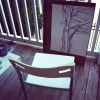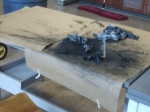You are currently browsing the tag archive for the ‘blog’ tag.
 The process log is simply a blog for documenting the process, support and insights of your visual thinking work. The log provides a venue for you to reflect on what you make in order to consider relevance and meaning for your work. Ideally through the process log you can see specific work in the context of your larger learning. In a class log, observe specific projects within the whole of the class. In multiple class logs over time, see your semester in the context of a year of learning, or the year within the four-year experience, etc. Learning and meaning emerge through reflecting on the specific experience. The process log is meant to create a mechanism for forming a habit of documenting and reflection.
The process log is simply a blog for documenting the process, support and insights of your visual thinking work. The log provides a venue for you to reflect on what you make in order to consider relevance and meaning for your work. Ideally through the process log you can see specific work in the context of your larger learning. In a class log, observe specific projects within the whole of the class. In multiple class logs over time, see your semester in the context of a year of learning, or the year within the four-year experience, etc. Learning and meaning emerge through reflecting on the specific experience. The process log is meant to create a mechanism for forming a habit of documenting and reflection.
The log can provide you with references and benchmarks to make visible patterns of interest that you might not otherwise notice. These patterns can lend insight for making sophisticated choices for further study, or simply provide a vehicle for getting to know yourself better: what you like to study, what approaches you seem to prefer, and what doesn’t work for you.
Use it as a repository for annotated research (a live bibliography), and for a reference “image bank” illustrating your increasing skills. Use it to review world-wide images with live links for accessibility, annotation and to provide paths to follow for further discovery. Post as often as you like but regularly enough so that it becomes a habit. Observe the time of day/week that are most efficient and effective for you to stimulate your learning. When are you most engaged? When is the best time for you for reflective writing and thinking?
How To Begin:
Any blog software will work. This blog is created in WordPress which is flexible and versatile and provides good support. It’s also free of charge at the basic level. But any blog software will work–as long as viewers can directly comment (important: please ensure that commenting does not require any kind of password or image word translating—I have found that that inhibits free comments from your peers because it is too much trouble). You are welcome to set privacy settings so that only your classmates and instructors can see your p-log if you would rather not yet go “world-wide”. www.wordpress.com will help you get started. Google’s Blogger is an excellent choice as well, and may work more seamlessly with course content. Lynda.com offers tutorials for you with tips on blogging and various softwares. Using tags and categories will make for more efficient and meaningful resource mining as you expand your site.
Post daily. Use your images and screen shots of where you are in your work (this is a great way to show your work as it changes, especially as you work in PhotoShop and make significant changes to the iamge). Try to make sure images are in focus and position yourself so that the subject you are shooting is uncluttered. For examples and further reading see Links under P-Log hall of fame to the left of this post, and read Bees, Being and Blogging, a post inspired by the June 2012 Summer Visual Thinking course. You can see a more general discussion on the process log on the “about” tab in this blog.
The process log is a means for telling the story of your learning in words and pictures. Like any good story-telling technique, a great process log embraces all the ways a concept might connect the maker to the “reader” and takes full advantage of what words can provide. You might create a provocative headline “This is how you stop time”; or a compelling topical sentence “ignoring where our waste is going and chastising those who help in that process is a way for people to deny their responsibility“; or exciting content “the first known valentine message was sent by a prisoner of war in 1415”; or humor on occasion: “I never knew that a chair could be so hard on a lady.”. Language is a tool. Well-crafted writing helps me disappear into the specific flavor of another person’s story.
Imagery, like words, has its own language. When a maker uses the distinctive properties of visual messaging, she makes her story stronger. A photograph created from an unusual point of view, or in the dramatic lighting of a particular time or day, or depicting unexpected subject matter, can lend details to a story that words can’t capture. A picture strategically placed may indeed be worth a thousand words.
Images can perform what text cannot. Words can reveal what images cannot. In a blog, both languages well-crafted and working in tandem can create a compelling transporting experience.
The right relationship of word and image comprise the main content and message of the blog, but the presentation of the work is an essential component for consideration. What is the overall format of the work? (In WordPress this option can be explored in the menu under “appearance”, but these principles apply to any visual framing device.) How one critically applies her knowledge of the elements and principles of design in order to best present her idea is a critical factor in creating engaging visual impact. A good rule of thumb in making format choices is to never choose a framework that detracts visually from the content. Formats aren’t yet standardized for digital media, so an artist can (and must) rely on her own critical eye to make good design choices. This compares to a general “standard” for turning in essays that are typed, double spaced, contain a 1.5” edge margin, and 12 point type; or to the white walls of a gallery with all picture frames on center at 60 inches from the floor. In the absence of an accepted standard format for digital presentation, the maker must ensure a strong “frame” that highlights, rather than competes with, the work.
 textovernebula
textovernebula
A successful example of good framing is in textovernebula’s blog, where the quality and variety of the images are “read” immediately because of the careful choice of a design style. The template they chose (Theme: Imbalance 2 by WPShower) features a simple meticulously structured format that focuses on the strength of the images and headlines in the blog and avoids disruptive decorative clutter. It is as if the page were a museum with walls that embrace the carefully curated work and invite us in to view them. I expect to be served tea. The white area surrounding the columns of body text suggests an abundance of space, fresh air, and time. The images shine through like intricately wrought chocolates in a delicately packaged text box of goodness. I want to select and savor them, one at a time. I am welcome here! Delightfully, when I click into the specific stories I am not disappointed. The photographs are nourishing, and the writing is strong in craft and interesting in content. Their blog connects me to a deeply considered and personal point of view.
baker160
Exciting visual connections and engaging, thought-provoking work that elicits an authentic experience is also found in the blog of baker160. A typical response from a student to an assignment that asks you to describe a class project sounds like a very dull subject to report on. So it is a double the thrill to read a work that expands the experience into an expanding complex of interwoven details. This process log is filled with delicacy and rigor and includes references ranging from the universal to the commonplace in an exciting subtle and smart interplay of personal narrative. It is a joy to read. It’s sort of a Renaissance blog, linking big (human) and small (personal) ideas with social and political content that is current and relevant. baker160 uses the power of the web to link thinking with evidence through her wide-ranging linked references that include mathematical formulas, the first recorded valentine, videos of gulf shrimp deformities and a shaky guitar player singing an acoustic valentine. Sample excerpts below give you a flavor for the blog, but I recommend reading–and subscribing to–it!
“At the house across the street from Rachel and John’s, a crew has vacuuming bees out from inside the walls. A colony of honeybees had established a hive inside the kitchen walls and had been rapidly expanding into the rest of the house. There was honey inside the walls and on them. I love that image—a kitchen that is being used to make food for a colony of bees. The house had mostly been cleaned by the time I could get a photo; I’m a bit allergic to bees, and I wasn’t getting too close to them while they were loose.”
And…
“This is something of a change for me. I’m more of a fan of words than images to convey ideas. It’s not that I don’t enjoy an idea expressed well through images, but I tend to think that there are very limited circumstances in which words aren’t the more precise way to convey a concept, philosophy, or argument. The well-explained graph or infographic is my ideal for words and images working together. Images can enhance and clarify a verbal explanation, but I always thought that whoever said a picture’s worth a thousand words was getting a terrible exchange rate. This is left-brained chauvinism, and I clearly need to think more about ways to convey information in a right-brained way.”
I have found that a great process log, like any great work of art, delights me with careful craft while a big idea sneaks in and makes its bed in my heart:
“I had a surprisingly similar problem with a pie I baked for a party this weekend. I intended to garnish this in the center, but there was an off-center ripple in the filling from when I’d moved it from the oven to the refrigerator. I knew it was off-center, but it was compelling as a place to put crushed Girl Scout Cookies and strawberries. I wound up correcting for it by expanding the garnished area to include the actual center of the pie. It’s interesting to me to see that there are so many circumstances in which patterns or design features make me think that I’m looking at the center of an object, but I’m really not.
It’s fascinating to me to start seeing these systematic errors in my visual thinking. It’s like taking a logic class for the first time and realizing that your closely-held opinions are based on fallacies and what the TV news lady with the pretty hair says.”
Attention to the craft of visual and written language makes the structure disappear, and lets me revel in the experience of ideas. The maker reveals who she is in her manor of writing and showing, and if she’s honest about that, I am interested and engaged. When you share experience and it feels true to me, you leave me asking questions about my world and I can see how your truths apply to me. Your experience increases my own.









